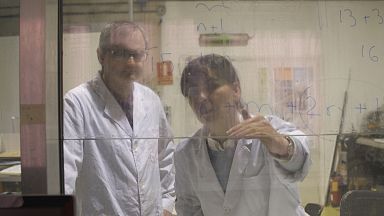Liquid windows and the energy-efficient buildings of tomorrow
On this episode of Futuris, we look at groundbreaking new technology that could hold the key to energy-efficient buildings of the future. We went to Sofia, Bulgaria, to find out how it works.
They look like ordinary windows but they're not. Inside each pane, there is a continuous flow of distilled water and glycol. The windows have been designed by researchers and architects working to create the energy-efficient buildings of tomorrow. The technology is being tested at an experimental pavilion in Sofia.
Inside each window, there is a constant flow of 70 litres of distilled water and 30 litres of ethylene glycol, which serves as antifreeze. Each transparent panel acts as an individual solar collector. Using solar cells, the windows absorb solar radiation and turn it into thermal energy to heat the building's interior.
Miglena Nikolaeva-Dimitrova is a physicist at the Bulgarian Academy of Sciences.
"The advantage of using liquids instead of air inside the glass is that water is denser, so it absorbs infrared light in a broader range".
Testing the system
Scientists at this European research project are using the experimental pavilion to test the system's efficiency.
Temperature and humidity are constantly monitored inside the building to see if energy can be produced and used long term or in very different climatic conditions.
"We measure the temperature inside the windows," explains Krasimir Zhivachki, a technical assistant at the Bulgarian Academy of Sciences. "We measure it every twenty centimetres, starting from the floor and then going up the window. This way we know how the heat is distributed inside every window. And so at the end, what we have is what we feed into the window and what is getting out of the window."
Reducing energy demands
The technology was developed here in Madrid.
Scientists want the water flow smart glazing system to ensure energy efficiency, not to act just as a transparent insulator. So the system must be able to maximize solar heat during the winter and avoid overheating in the summer.
Juan Antonio Hernandez Ramos is Professor of Numerical Analyses and Computer Science at Madrid's Polytechnic University. He explains how the windows work:
"If the outside temperature is too cold, we can stop the water flow. The sun heats up the water chamber between the glasses and the windows become hotter. If it outside temperature is warm, or if inside the building the temperature is already comfortable, we can turn on the water flow to distribute the energy to other places in the building. Transparent glass acts in active ways; it acts like a skin that allows the whole building to thermo-regulate itself"
Scientists think the technology could help design the so-called "Nearly Zero Energy Buildings" of the future, as the European Union seeks to dramatically increase the energy efficiency of new building designs.
"The idea is to have buildings that reduce their energy demands as much as possible -- while at the same time producing thermal energy," says Belen Moreno Santamaria, an architect at the Polytechnic University. "This is our solution to improve and maximize the net balance of energy that every building needs".
Scaling up
Researchers say the system's technology is now ready to be scaled up to industrial production.
"We can now launch the product on the market," says Dieter Bruggemann, Professor of Thermal Engineering at the University of Bayreuth and an InDeWaG project coordinator.
"Of course, we have to prove that it also works on bigger buildings besides these prototypes which are already running successfully. But we do think that it is now worth installing it in full-scale buildings".
While waiting for investors to get involved, measurements at the demonstration pavilion in Sofia will continue for the next 10 years.












